- Clone
- SP17 (See other available formats)
- Regulatory Status
- RUO
- Other Names
- SYP, Synaptophysin, Major synaptic vesicle protein P38
- Isotype
- Mouse IgM, κ
- Ave. Rating
- Submit a Review
- Product Citations
- publications
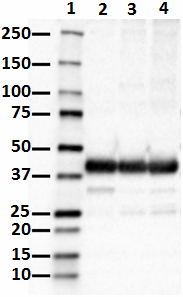
-

Western blot of purified anti-Synaptophysin antibody (clone SP17). Lane 1: Molecular weight marker; Lane 2: 20 µg of human brain lysate; Lane 3: 20 µg of mouse brain lysate; Lane 4: 20 µg of rat brain lysate. The blot was incubated with 1 µg/mL of the primary antibody overnight at 4°C, followed by incubation with HRP labeled goat anti-mouse IgM. Enhanced chemiluminescence was used as the detection system. -

ICC staining of purified anti-Synaptophysin antibody (clone SP17) on U251MG cells. The cells were fixed with 4% PFA, permeabilized with a buffer containing 0.1% Triton X-100 and 0.25% BSA, and blocked with 2% normal goat serum and 0.02% BSA. The cells were then incubated with 10 µg/ml of the primary antibody overnight at 4°C, followed by incubation with 2.5 °g/ml of Alexa Fluor® 647 goat anti-Mouse IgM for one hour at room temperature. Nuclei were counterstained with DAPI, and the slides was mounted with ProLong™ Gold Antifade Mountant. The image was captured with a 40X objective. Scale bar: 50 µm -

IHC staining of purified anti- anti-Synaptophysin antibody (clone SP17) on formalin-fixed paraffin-embedded mouse brain tissue. Following antigen retrieval using Sodium Citrate H.I.E.R., the tissue was incubated with 1 µg/ml of the primary antibody overnight at 4°C. BioLegend´s Ultra-Streptavidin (USA) HRP kit (Multi-Species, DAB, Cat. No. 929901) was used for detection followed by hematoxylin counterstaining, according to the protocol provided. The image was captured with a 40X objective. Scale bar: 50 µm -

IHC staining of purified anti- anti-Synaptophysin antibody (clone SP17) on formalin-fixed paraffin-embedded rat brain tissue. Following antigen retrieval using Sodium Citrate H.I.E.R., the tissue was incubated with 1 µg/ml of the primary antibody overnight at 4°C. BioLegend´s Ultra-Streptavidin (USA) HRP kit (Multi-Species, DAB, Cat. No. 929901) was used for detection followed by hematoxylin counterstaining, according to the protocol provided. The image was captured with a 40X objective. Scale bar: 50 µm -

IHC staining of purified anti-Synaptophysin (clone SP17) on formalin-fixed paraffin-embedded human brain tissue. Following antigen retrieval using Sodium Citrate H.I.E.R (Cat. No. 928602), the tissue was incubated with 5 µg/mL of the primary antibody overnight at 4°C, followed by incubation with 2.5 µg/mL of Alexa Fluor® 647 goat anti-mouse IgG for one hour at room temperature. The slide was mounted with Fluoromount-G™, with DAPI. The image was captured with a 40X objective. Scale Bar: 50 µm
| Cat # | Size | Price | Quantity Check Availability | Save | ||
|---|---|---|---|---|---|---|
| 837103 | 25 µg | 81€ | ||||
| 837104 | 100 µg | 221€ | ||||
Synaptophysin, also known as major synaptic vesicle protein P38, is encoded by the SYP gene in humans and is located on the short arm of the X chromosome. Synaptophysin is expressed in neuroendocrine cells as well as all neurons in the CNS that participate in synaptic transmission. Synaptophysin is a synaptic vesicle glycoprotein, and interacts with synaptobrevin. It has been implicated in X-linked mental retardation and can be used as a specific marker for cells of the adrenal medulla and pancreatic islets. As such, it can be used to identify tumors that are derived from those cells, including neuroblastoma, retinoblastoma, medulloblastoma, and others.
Product DetailsProduct Details
- Verified Reactivity
- Human, Mouse, Rat
- Antibody Type
- Monoclonal
- Host Species
- Mouse
- Immunogen
- This antibody was raised against a crude synaptic preparation from post mortem human brain.
- Formulation
- Phosphate-buffered solution, pH 7.2, containing 0.09% sodium azide.
- Preparation
- The antibody was purified by affinity chromatography.
- Concentration
- 0.5 mg/ml
- Storage & Handling
- The antibody solution should be stored undiluted between 2°C and 8°C.
- Application
-
WB - Quality tested
ICC, IHC-P - Verified
SB - Community verified - Recommended Usage
-
Each lot of this antibody is quality control tested by Western blotting. For Western blotting, the suggested use of this reagent is 1.0 - 10 µg per mL. For immunocytochemistry, a concentration range of 1.0 - 10 μg/mL is recommended. For immunohistochemistry on formalin-fixed paraffin-embedded tissue sections, a concentration range of 1.0 - 10 µg/mL for chromogenic staining and 0.5 - 2.0 µg/mL for fluorescent staining is suggested. It is recommended that the reagent be titrated for optimal performance for each application.
- Application Notes
-
SP17 reacts with native, denatured and recombinant synaptic vesicle protein synaptophysin expressed in CHO cells. The antibody is particularly valuable for immunocytochemical studies of the brain due to its stability in formalin sections.
- Additional Product Notes
-
This product has been verified for IHC-F (Immunohistochemistry - frozen tissue sections) on the NanoString GeoMx® Digital Spatial Profiler. The GeoMx® enables researchers to perform spatial analysis of protein and RNA targets in FFPE and fresh frozen human and mouse samples. For more information about our spatial biology products and the GeoMx® platform, please visit our spatial biology page.
- Application References
- Product Citations
-
- RRID
-
AB_2783411 (BioLegend Cat. No. 837103)
AB_2783411 (BioLegend Cat. No. 837104)
Antigen Details
- Structure
- Synaptophysin is a 313 amino acid protein with an apparent molecular mass of 34 kD.
- Distribution
-
Tissue distribution: Brain, pancreas, adipose and soft tissue, gastrointestinal tract, bone marrow, and immune system.
Cellular Distribution: Plasma and synaptic vesicle membrane. - Function
- Synaptophysin plays a role in synaptic vesicle docking and membrane fusion.
- Interaction
- SRCIN1, also interact with itself to form homohexamer or homotetramer
- Biology Area
- Cell Biology, Neuroscience, Synaptic Biology
- Molecular Family
- Presynaptic proteins
- Antigen References
-
- Zhang L, et al. 2018. Medicine (Baltimore). 97(29):e11487
- Moris, et al. 2018. Anticancer res. 38(2):601
- Hami J, et al. 2017. J pediatr Neurosci. 12(3):215
- Gene ID
- 6855 View all products for this Gene ID
- UniProt
- View information about Synaptophysin on UniProt.org
Related Pages & Pathways
Pages
Related FAQs
- If an antibody clone has been previously successfully used in IBEX in one fluorescent format, will other antibody formats work as well?
-
It’s likely that other fluorophore conjugates to the same antibody clone will also be compatible with IBEX using the same sample fixation procedure. Ultimately a directly conjugated antibody’s utility in fluorescent imaging and IBEX may be specific to the sample and microscope being used in the experiment. Some antibody clone conjugates may perform better than others due to performance differences in non-specific binding, fluorophore brightness, and other biochemical properties unique to that conjugate.
- Will antibodies my lab is already using for fluorescent or chromogenic IHC work in IBEX?
-
Fundamentally, IBEX as a technique that works much in the same way as single antibody panels or single marker IF/IHC. If you’re already successfully using an antibody clone on a sample of interest, it is likely that clone will have utility in IBEX. It is expected some optimization and testing of different antibody fluorophore conjugates will be required to find a suitable format; however, legacy microscopy techniques like chromogenic IHC on fixed or frozen tissue is an excellent place to start looking for useful antibodies.
- Are other fluorophores compatible with IBEX?
-
Over 18 fluorescent formats have been screened for use in IBEX, however, it is likely that other fluorophores are able to be rapidly bleached in IBEX. If a fluorophore format is already suitable for your imaging platform it can be tested for compatibility in IBEX.
- The same antibody works in one tissue type but not another. What is happening?
-
Differences in tissue properties may impact both the ability of an antibody to bind its target specifically and impact the ability of a specific fluorophore conjugate to overcome the background fluorescent signal in a given tissue. Secondary stains, as well as testing multiple fluorescent conjugates of the same clone, may help to troubleshoot challenging targets or tissues. Using a reference control tissue may also give confidence in the specificity of your staining.
- How can I be sure the staining I’m seeing in my tissue is real?
-
In general, best practices for validating an antibody in traditional chromogenic or fluorescent IHC are applicable to IBEX. Please reference the Nature Methods review on antibody based multiplexed imaging for resources on validating antibodies for IBEX.
Other Formats
View All Synaptophysin Reagents Request Custom Conjugation| Description | Clone | Applications |
|---|---|---|
| Purified anti-Synaptophysin | SP17 | WB,ICC,IHC-P,SB |
| Alexa Fluor® 647 anti-Synaptophysin | SP17 | IHC-P |
Customers Also Purchased
Compare Data Across All Formats
This data display is provided for general comparisons between formats.
Your actual data may vary due to variations in samples, target cells, instruments and their settings, staining conditions, and other factors.
If you need assistance with selecting the best format contact our expert technical support team.
-
Purified anti-Synaptophysin
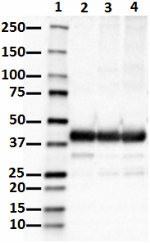
Western blot of purified anti-Synaptophysin antibody (clone ... 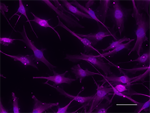
ICC staining of purified anti-Synaptophysin antibody (clone ... 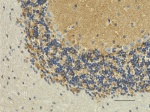
IHC staining of purified anti- anti-Synaptophysin antibody (... 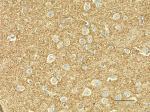
IHC staining of purified anti- anti-Synaptophysin antibody (... 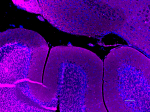
IHC staining of purified anti-Synaptophysin (clone SP17) on ... -
Alexa Fluor® 647 anti-Synaptophysin

IHC staining of Alexa Fluor® 647 anti-Synaptophysin (clone S...

 Login / Register
Login / Register 





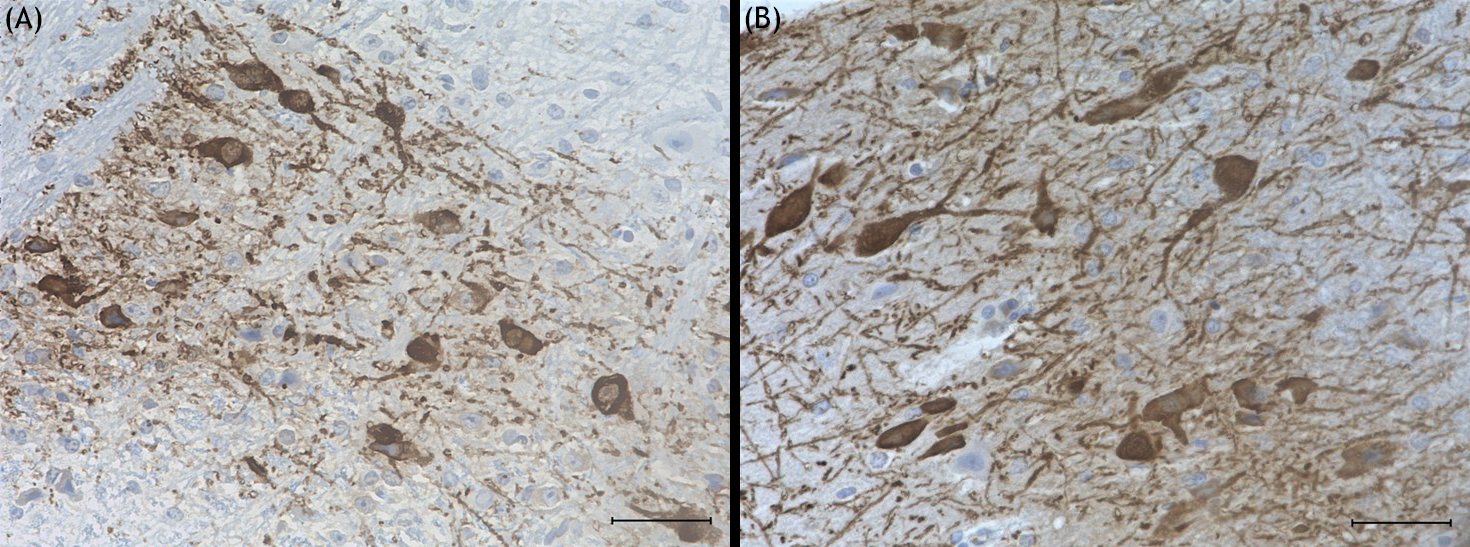





Follow Us